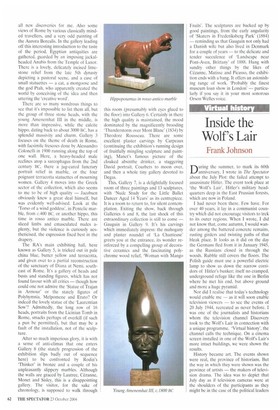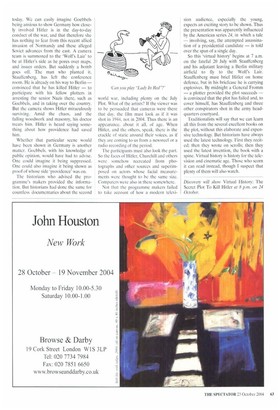Inside the Wolf's Lair
Frank Johnson
During the summer, to mark its 60th 1./anniversary, I wrote in The Spectator about the July Plot: the failed attempt to assassinate Hitler. The event took place at 'the Wolfs Lair', Hitler's military headquarters deep in the East Prussian forests, which are now in Poland.
I had never been there. Few have. For over 40 years, it lay in a communist country which did not encourage visitors to trek to its outer regions. When I wrote, I did not know that, come autumn, I would wander among the battered concrete remains, rusting girders and twisting paths of that bleak place. It looks as it did on the day the Germans fled from it in January 1945, as the Russians closed in through the woods. Rubble still covers the floors. The Polish guide must use a powerful electric lamp to show us down the narrow corridors of Hitler's bunker; itself no cramped, underground refuge like the one in Berlin where he met his end, but above ground and more a huge pyramid.
Nor did I realise that today's technology would enable me — as it will soon enable television viewers — to see the events of 20 July 1944, recreated as never before. I was one of the journalists and historians whom the television channel Discovery took to the Wolf s Lair in connection with a unique programme. 'Virtual history', the channel calls the technique. On a cinema screen installed in one of the Wolf's Lair's more intact buildings, we were shown the results.
History became art. The events shown were real, the province of historians. But the way in which they were shown was the province of artists — the makers of television drama. The idea was to depict that July day as if television cameras were at the shoulders of the participants as they might be in the case of the political leaders today. We can easily imagine Goebbels being anxious to show Germany how closely involved Hitler is in the day-to-day conduct of the war, and that therefore she has nothing to fear from this recent allied invasion of Normandy and these alleged Soviet advances from the east. A camera team is summoned to the 'Wolfs Lair' to be at Hitler's side as he pores over maps, and issues orders. But suddenly a bomb goes off. The man who planted it, Stauffenberg, has left the conference room. He is already on his way to Berlin — convinced that he has killed Hitler — to participate with his fellow plotters in arresting the senior Nazis there, such as Goebbels, and in taking over the country. But the camera shows Hitler miraculously surviving. Amid the chaos, and the falling woodwork and masonry, his doctor treats him. Hitler is heard saying something about how providence had saved him.
Whether that particular scene would have been shown in Germany is another matter. Goebbels. with his knowledge of public opinion, would have had to advise. One could imagine it being suppressed. One could also imagine it being shown as proof of whose side 'providence' was on, The historians who advised the programme's makers provided the information. But historians had done the same for countless documentaries about the second world war, including plenty on the July Plot, What of the artists? If the viewer was to he persuaded that cameras were there that day, the film must look as if it was shot in 1944, not in 2004. Thus there is an appearance, about it all, of age, When Hitler, and the others, speak, there is the crackle of static around their voices, as if they are coming to us from a newsreel or a radio recording of the period.
The participants must also look the part. So the faces of Hitler, Churchill and others were somehow recreated from photographs and other sources and superimposed on actors whose facial measurements were thought to he the same size. Computers were also in there somewhere.
Not that the programme makers failed to take account of how a modern televi
sion audience, especially the young, expects an exciting story to be shown. Thus the presentation was apparently influenced by the American series 24, in which a tale
involving, say, the attempted assassination of a presidential candidate — is told over the span of a single day.
So this 'virtual history' begins at 7 a.m. on the fateful 20 July with Stauffenberg and his adjutant leaving a Berlin military airfield to fly to the Wolf s Lair. Stauffenberg must brief Hitler on home defence, but in his briefcase he is carrying explosives. By midnight a General Fromm —a plotter provided the plot succeeds — is convinced that the plot has failed and, to cover himself, has Stauffenberg and three other conspirators shot in the army headquarters courtyard.
Traditionalists will say that we can learn all this from the several excellent hooks on the plot, without this elaborate and expensive technology. But historians have always used the latest technology. First they recited; then they wrote on scrolls; then they used the latest invention, the book with a spine. Virtual history is history for the television and cinematic age. Those who scorn it can read instead, though I suspect that plenty of them will also watch.
Discovery will show Virtual IIistory: The Secret Plot To Kill Hitler at 8 p.m. on 24 October.

























































































 Previous page
Previous page